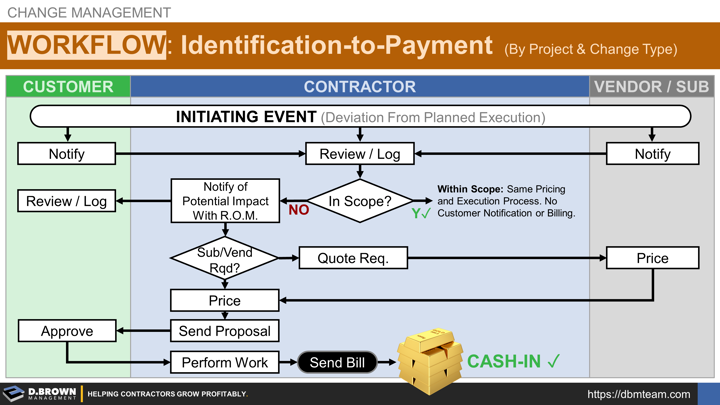Most contractors don’t have a consistent internal process much less a deep understanding of what the process looks like downstream or upstream.
This lack of knowledge impacts every aspect of change management, including the customer relationship, profitability, and cash flow. Understanding this entire value-stream is really about learning to see.
The workflow shown is a simple example. This needs to be expanded significantly for your company and modified for each project. Coach your project team members to map this out in more detail with the objectives being:
- Shorten time between start of work performed and cash-in.
- Improve the customer experience by making the process efficient for them.
For each step know the following:
- Who is primarily responsible and who is involved?
- How would you rate your relationship with that person? Will they go out of their way to help you?
- What is the estimated timing of how long each step should take? What can shorten it?
- What specifically is required at each step per the contract, other standards or preferences?
- What tools are used for each step?
Improvement Possibilities: Looking at this simple example - some of the initial questions that would come to mind are:
- Do we have a good process including people with the right experience to identify every deviation from the planned execution of the project? This is where it all begins and requires the most experienced people to identify RFIs and changes as soon as possible. This does not mean you will get paid for all of the changes or even submit them, but identifying and logging them is a crucial first step.
- Logging all the possible changes is an entry-level function and a great way for a new Project Engineer, Field Engineer, Project Coordinator, or Project Administrator level person to learn the nuances of building a project from the most experienced people who are identifying the changes.
- The decision on whether it is in or out of scope and whether to proceed forward requires a more experienced person who knows the technical aspects of building, the contractual aspects of managing a project, and the customer relationship dynamics. Escalating these to a higher-level person for decision making improves outcomes while providing an opportunity for that more entry-level person to learn how those decisions are being made.
- For changes over a certain size or type, you may want to add in a review step by someone with more experience who can coach on details of pricing and putting together the proposal. Again, this will both improve outcomes immediately and develop talent.
- This workflow does not include any aspects of routine weekly and/or monthly management from higher level managers to ensure the process is working as expected.
What other improvements can you see when looking at your own change management process?
How often do you audit your change management process to ensure it is happening the way you intend?
Please keep in mind that all your systems change with each stage of growth, including the change management process. If you are having problems in this area, it could just be that you have outgrown your prior system.

